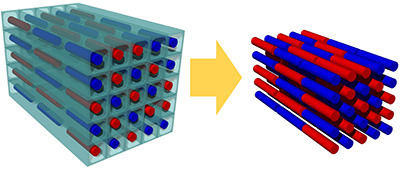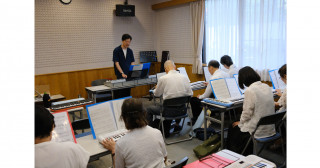
Assc Prof Uemura
A team of researchers led by Dr Susumu Kitagawa at Kyoto University's groundbreaking Institute for Integrated Cell-Material Sciences (iCeMS) has developed a new technique to successfully blend different types of polymers for the first time. This finding, published on 1 July in Nature Communications , will significantly contribute to the development of novel smart materials.
Polymers have important roles in many industries in the form of plastics and fibers and are used in everything from car tires, electronics, to blood dialysis membranes.
However, as 1974 Nobel Prize-winning chemist Paul J Flory revealed, blending polymers together to form so-called "polymer alloys" at the molecular level has so far been almost impossible.
Previous methods of polymer blending have historically only yielded poor results, forming segregated polymer domains, and this has been a significant barrier to producing many scientifically and technologically useful materials, the advanced plastics of the future. Until now.
By taking a fundamentally different approach, iCeMS scientists have made a discovery that makes the homogeneous mixing of chemically immiscible substances a reality.
The team adopted a templating approach, building what may be imagined as "removable scaffolding" using materials called porous coordination polymers (PCPs). These microscopic materials have numerous pores and a climbing-frame structure which functions as a kind of frame within which two polymers may blend together under chemical treatment. Once the process is complete the PCPs are removed, much as workmen remove the supports once a building is complete.
Using this new technique, the iCeMS group succeeded in blending polystyrene and poly(methyl methacrylate), better known as PMMA, at the molecular level. Polystyrene is renowned for its strength, light weight, and low cost. PMMA, commonly referred to by the trade names "Perspex" and "Plexiglass", has myriad applications from medical implants to aquarium windows to the exterior lights of automobiles. The resulting "plastic alloy" will retain the properties of both.
"Our technique results in the ultimate blend," explains key researcher Takashi Uemura, of Kyoto University's Graduate School of Engineering. "It is a quick and very cost-effective procedure. This discovery will allow the development of a host of new blended polymers with applications across many industries. I am genuinely excited by this development in our field".

By adopting a templating approach using porous materials, the homogeneous mixing of chemically immiscible substances has become a reality.
Paper Information
[DOI] http://dx.doi.org/10.1038/ncomms8473
Takashi Uemura, Tetsuya Kaseda, Yotaro Sasaki, Munehiro Inukai, Takaaki
Toriyama, Atsushi Takahara, Hiroshi Jinnai & Susumu Kitagawa
"Mixing of immiscible polymers using nanoporous coordination templates"
Nature Communications 6, Article number: 7473 Published 01 July 2015





